by Joanne
Wiertella
(click on photos to enlarge image)
THE LANGUAGE OF FLOWERS
Flowers have been greatly esteemed since the dawn of
civilization. Ancient Egyptians painted them on their
temple walls and the withered remains of flowers have
been found in ancient tombs around the world.
The colorful and fragile beauty of flowers has given
rise to countless culturally symbolic meanings, and
folktales about flowers have abounded from the earliest
times --although not in the Western World until the end
of the Middle Ages. Floral representations have been
added to all forms and materials of artistic effort--
paintings, metal ware, furniture, fabric and so on.
Floral names have even graced our daughters. Although
less common now, names such as Rose, Daisy, Myrtle,
Pansy, and even Honey, were once quite popular.
In Europe, correspondence through flowers began in the
1700’s, when Charles II of Sweden introduced the Persian
custom referred to as the "Language of Flowers".
The advent of the Industrial Revolution and the reign of
Queen Victoria (of England) combined to spread the idea
of sentimentality with floral motifs. Victorian homes
were elaborately decorated with florals on the walls,
furniture, paintings, utensils, and trinkets. A gift of
flowers held much significance; each blossom conveying a
message.
An entire conversation could be expressed through the
exchange of flowers!
The many legends attached to flowers might be divided
into three classes: the mythological, the
ecclesiastical/ historical, and the poetical.
The mythological legends often relate to "creation"
stories as well as the transformation by the gods of
luckless nymphs and youths into flowers and trees, which
have since kept their names. Many stories describe the
origin of the color of blossoms. For example, white
flowers are represented as having originated from fallen
tears, and pink or red flowers from blushes or blood.
The ecclesiastic/historical legends are generally due to
the reverent imaginings of Catholic monks. While tending
their flowers in the quiet and seclusion of monastery
gardens, they may have associated a certain flower with
a memory of some favorite saint or martyr, and allowed
their fancy to weave a fiction to perpetuate the memory
of that saint. Many historical legends pertain to
favorite sons and daughters of the Church.
The poetical legends include the numerous fairy tales in
which flowers and plants play an important part, and
which may include elves, trolls and witches. In more
recent history (the Victorian era), flowers came to be a
language of symbolic content
The following represents a brief summary of just a few
of the many tales about the blossoms that came to hold
so much meaning during the Victorian period.
Grape
Grapes, one of the oldest cultivated fruits, have
appeared as a decorative motif throughout time in nearly
every culture. In some countries, the grape was believed
to have been the forbidden fruit of the Tree of
Knowledge in the Garden of Eden.
They have been said to signify fertility, sacrifice,
hospitality, and charity. To dream of Grapes foretells
to the maiden that her husband will be cheerful and a
great songster. If the dreamer is in love, the grapes
foretell a speedy union, and denote much happiness in
the marriage and success in trade.
According to another authority, to dream that you see
clusters of Grapes hanging round about you, predicts
future advancement and honor. To the maid it implies
marriage with an ambitious man, who will arrive at great
station, but die early.
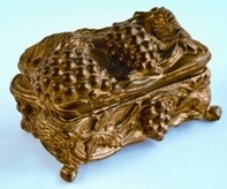 |
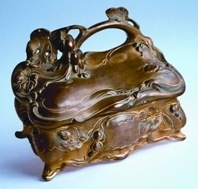 |
Grape: 1908-14; P.A. Coon
5 x 3 x 3"
|
Grape: 1905-08; Jennings Brothers
6 ½ x 3 ½ x 4 ½ "
|
Forget-Me-Not
According to a German tale full of melancholy and
romance, a young couple was walking along the banks of
the Danube on the eve of being united. They saw a
cluster of Forget-Me-Nots floating on the stream which
was bearing it away.
The bride-to-be admired the beauty of the flower and
lamented its fatal destiny. Her lover plunged into the
water to secure the flowers. No sooner had he caught
them than he found himself sinking.
Making a last effort, he threw the bouquet onto the bank
at the feet of his betrothed and, at that moment of
disappearing forever, exclaimed, "Vergiss mein nicht!" (Forget
me not!)
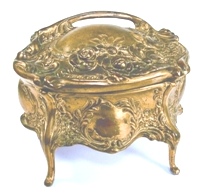 |
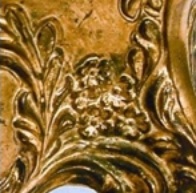 |
Forget-Me-Not: 1904-08;
Brainard & Wilson - 6 x 4 x 4 ½ "
|
Forget-Me-Not Detail
|
Lily of the Valley
Lilies of the Valley, also called "Virgin’s Tears",
have blossoms that were thought (during the mid-1500’s)
to possess a perfume highly medicinal against "nervous
affections". The water distilled from them was in such
great repute that it was kept only in vessels of gold
and silver.
There is also a legend that in the forest of St. Leonard,
where the hermit-saint once dwelt, fierce encounters
took place between him and a dragon. The holy man
finally succeeded in driving the dragon away, and the
scenes of their battles were revealed afresh each year,
when beds of fragrant Lilies of the Valley appeared
wherever the earth had been sprinkled by the blood of
the warrior saint.
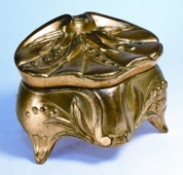 |
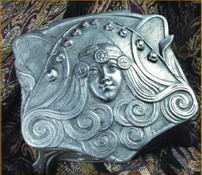 |
Lily of the Valley: 1912;
Manufacturer Unknown
3 ½ x 2 ¾ x 2 ¾"
|
Lily of the Valley: 1906-08;
Jennings Brothers
5 ½ x 5 x 3 ½"
|
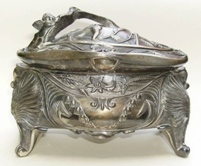 |
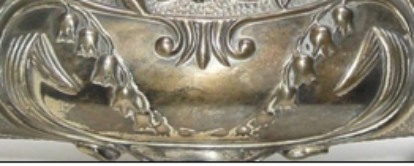 |
Lily of the Valley: 1908-14;
P.A. Coon
6 x 3 ½ x 4 ¾"
|
Lily of the Valley
Detail
|
Daisy
The Daisy has been called the "poet's darling."
Shakespeare and Wordsworth, and many poets in between,
have used the Daisy to represent the quality of pure
innocence. The ancient English name of this flower was
Day's Eye, from which came its present name.
Chaucer called it the "ee of the daie", probably from
its habit of closing its petals at night and during
rainy weather. There once was a popular superstition
that if you failed to put your foot upon the first Daisy
of spring, Daisies would grow over you before the year
was out.
Another tale was that Spring had not arrived until you
could put your foot upon twelve Daisies. Today, we enact
the popular tradition. "He loves me, he loves me not".
It is considered lucky to dream of Daisies in Spring or
Summer.
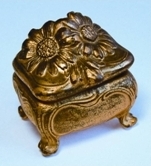 |
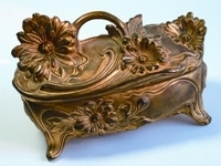 |
Daisy: 1906;
Weidlich Brothers
1 7/8 x 1 ½ x 1 ¾"
|
Daisy: 1906-08;
Jennings Brothers
5 ½ x 5 x 3 ½"
|
Clover
The common Clover has a rich symbolic folklore not
just about its leaves, but also its blossoms. It was
used in festivals of the ancient Greeks. Hope was
depicted as a little child standing on tiptoe, holding a
Clover blossom in his hand. The Druids also used clover
in their ceremonies.
More recently, to dream of seeing a field of Clover
indicated health, prosperity, and much happiness.
A fairy tale from Cornwall goes like this:
One evening a maiden set out to milk the cows later
than usual, and the stars had begun to shine before she
completed her task. An enchanted cow was the last to be
milked, and the pail was so full that the milk-maid
could hardly lift it to her head. So she gathered some
handfuls of grass and Clover, spreading it upon her
head, in order to carry the milk-pail more easily.
But, no sooner had the Clover touched her head, then
suddenly hundreds of little people appeared surrounding
the cow, dipping their tiny hands into the milk and
gathering it with Clover flowers.
When the astonished milk-maid reached home, she
recounted this wonderful experience to her mistress who
at once cried out, "Ah! You put a four-leafed clover on
your head"
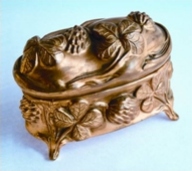 |
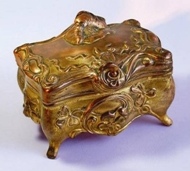 |
Clover: 1913+;
Benedict Proctor
3 ½ x 2 x 2 ½ "
|
Clover and Poppy: 1904-07;
Brainard & Wilson
4 x 3 x 2 3/4"
|
Violet
The Violet has always been a favorite among the
first flowers of Spring. Its quiet beauty and love of
sheltered spots have made it the symbol of true worth
that shrinks from the parade.
During the Middle Ages, there existed a curious
tradition in Toulouse, France, called the "Floral Games",
which filled the poetry of that nation with symbolic
images drawn from floral and botanic subjects.
These poetical contests were held annually, and the
prizes were awarded early in May. The author of the best
poetical composition was presented with a golden violet,
and the secondary writers with a silver violet.
A melodramatic ballad involves the fair lady Clemence
Isaure, sometimes called the "Queen of Poetry", who some
say was instrumental in the revival of these games:
A knight was deeply enamored with Clemence, and she
returned his passion. Her father, however, had chosen
another husband. Clemence resisted the union saying that
her life was at her father's disposal but that, as long
as she should live, her heart belonged to the knight. So
the father had her chained and held in a strong tower,
promising to kill the knight if he could.
The knight learned of his mistress's imprisonment and,
like a true lover, went to the tower and repeated his
vows and sorrows to Clemence. She presented him with a
nosegay of violets, that he might know of her constancy,
and warned him of her father's threat.
The knight departed to join the king's court but, on his
way, learned that the English were marching against the
city. He returned, finding only one old man still
resisting the enemy. The knight hurried to his
assistance and saw that it was the father of his only
love, Clemence. At the moment that a fatal stroke was
aimed at the old man, the knight rushed forward and
received the mortal wound himself. Dying in the old
man's arms, the knight presented the flowers he had
received, begging they should be returned to Clemence.
The father relented, and in great sorrow told his
daughter of the untimely death of her knight. Clemence,
in turn, fell victim to her despair and anguish, and
followed her lover to the grave. Since then, the violet
has become a symbol of faithfulness and constancy.
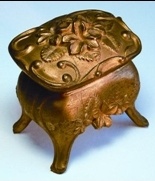 |
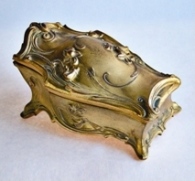 |
Violet: 1912;
Manufacturer Unknown
2 ½ x 2 x 2 3/4 "
|
Violet: 1911;
Weidlich Brothers;
4 ½ x 2 ¾ x 2 ¾"
|
Joanne Wiertella - 2007 -
contact:
jewelboxbook@sbcglobal.net
author of "The Jewel Box Book: The Definitive
Guide to American Art Metal Jewelry Boxes
1900-1925"
208 pages - full color book - more information
available at
www.jewelboxbook.com
|
|
|
|
 ASSOCIATION OF SMALL COLLECTORS OF ANTIQUE SILVER
ASSOCIATION OF SMALL COLLECTORS OF ANTIQUE SILVER













